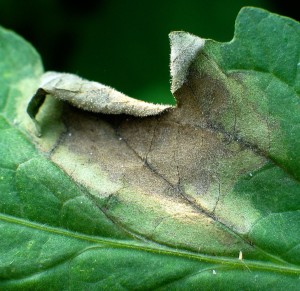WGXC-90.7 FM


Tomato blight again?
May 03, 2010 10:23 pm
[caption id="" align="alignleft" width="200" caption="Blight on tomato leaf."] [/caption]Meg McGrath, a plant pathologist at Cornell University Agriculture Department, shares these tips for anyone who would like to grow tomatoes in the wake of last year's blight (h/t Rural Intelligence):
[/caption]Meg McGrath, a plant pathologist at Cornell University Agriculture Department, shares these tips for anyone who would like to grow tomatoes in the wake of last year's blight (h/t Rural Intelligence):
 [/caption]Meg McGrath, a plant pathologist at Cornell University Agriculture Department, shares these tips for anyone who would like to grow tomatoes in the wake of last year's blight (h/t Rural Intelligence):
[/caption]Meg McGrath, a plant pathologist at Cornell University Agriculture Department, shares these tips for anyone who would like to grow tomatoes in the wake of last year's blight (h/t Rural Intelligence):The good news for gardeners is that they are starting with a relatively clean slate this year. Phytophthora infestans, the fungus-like pathogen that causes late blight in tomatoes, potatoes and other tomato-family plants (Solanaceae), currently requires living plant tissue to survive overwinter in the Northeast. That’s why the disease is relatively rare in the region. The bad news is, potato tubers are living plant tissue. So any late-blight-infested potato tubers that survived in your soil, compost pile or root cellar could harbor the pathogen and give it an early start again this season. “Destroy leftover potatoes and any volunteer potato plants as soon as they sprout,” McGrath urges. “Do not wait until you see symptoms. By then, new spores likely will have already developed and spread to other gardens or farmers’ fields.”
Other tips
Keep plants dry. The late blight pathogen thrives in cool, wet weather. That’s because it requires moisture to infect plants, grows best when it’s cool, and clouds protect spores from lethal UV radiation when they are dispersed by wind. Even in absence of rain, the pathogen can infect plants if the relative humidity is 90 percent or more. If plants need watering, water the soil – not the foliage.
Be vigilant. Inspect plants at least once a week – more often if weather is cool and wet. Immediately remove and bag foliage you suspect might be infected.
Act quickly. If symptoms continue despite removing infected foliage, consider removing plants entirely – sooner rather than later.
Dispose of plants properly. To reduce disease spread, remove infected plants during the middle of a sunny day after leaves have dried, if possible....Seal plants in garbage bags and leave them in the sun for a few days to kill plants and the pathogen quickly before placing in the trash or burying underground or deep in a compost pile.
Read the entire story here.


